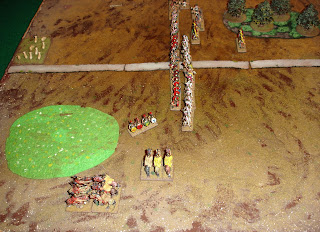The first event is the appearance of Lee in the 6/62 Confederate Leader pick.
The build trickle for 6/62
I converted 3x2-2 militia to 2-3 infantry,
converted a 5-1 garrison to 5-3 infantry and built another 5-1 garrison.
Slim pickings for both sides
For the Union, Wilson makes repeated attacks on Winchester
In the West the Union gunboats run the forts and suffer 60% losses.
However they now disrupt Confederate supply.
I should have done this much earlier. Doh!
Before the rebs could build their forts and before they could get their supply depots established.
Disaster as the Rebs hit McClellan hard winning a major victory,
further damaging Union political aspirations.
It could have been worse as the Rebs had an opportunity to continue the battle but failed.
However, this might have been the deciding battle of the war...
McClellan escapes.
The fighting for Winchester continues.
The Union initiative chits for this sorry turn were 1, 0. 0. 1. It was that last one that allowed McClellan to escape.
The Union rebuild their river flotillas.
I also augmented a 7-3 to a 10-3 and with my last personnel point built a 1-1 garrison
The Rebs build an ironclad.
Smith is sent to reinforce Savannah.
Rosecrans captures Morehead City, but is rather exposed as General Lee is heading his way with a much bigger army. At least that hex between the two cities is unfriendly territory for the rebs which may cause Lee to think carefully about force marching to attack.
For 7/62 cycle the chit system has changed and the Union draw was 1,2,3,3 compared to the Confederate 5,1,2,1. It makes a difference.
Some rule observations
We failed to realise Railroad repair units required initiative to move and make their repairs [5.27]. We will now do so.
We failed to realise that when a general is appointed to a infantry corps he can no longer command cavalry [15.11]. This doesn't seem right and we will not be imposing this restriction.
River supply is definitely blocked by forts, but it is unclear that enemy flotillas also block. They certainly stop naval transports and so it is reasonable to think they also stop supply.
Political Points for major victory don't take into account the size of an action, but maybe this means that HQs should not be used to move around small forces.
The optional rules we are using are retreat after combat (enables a large force to brush aside a small blocking force, but we are yet to use it), Confederate Initiative pick and Entrenchments (if we get to 1864, but I'm dubious about this rule given it is counter limited). Even though it is recommended we are not using initiative reduction for commanders out of a line of communications. While it sounds reasonable, the supply system already limits the wisdom of getting beyond your LoC and generals initiative values already seem to take this into account (also noting that General in direct command often didn't do their political leaders bidding).
One aspect of the rules that concerns me is Attack from march. It is kind of like overrun, but really just seems a way of causing attrition. Hasty attack? If so why not use supply and also require general to use initiative. I can see without it you could shield your front with tiny forces that would require initiative and supply to attack. As it is, if the defender is just 1 point you need to get better than 5% to eliminate it.




















































